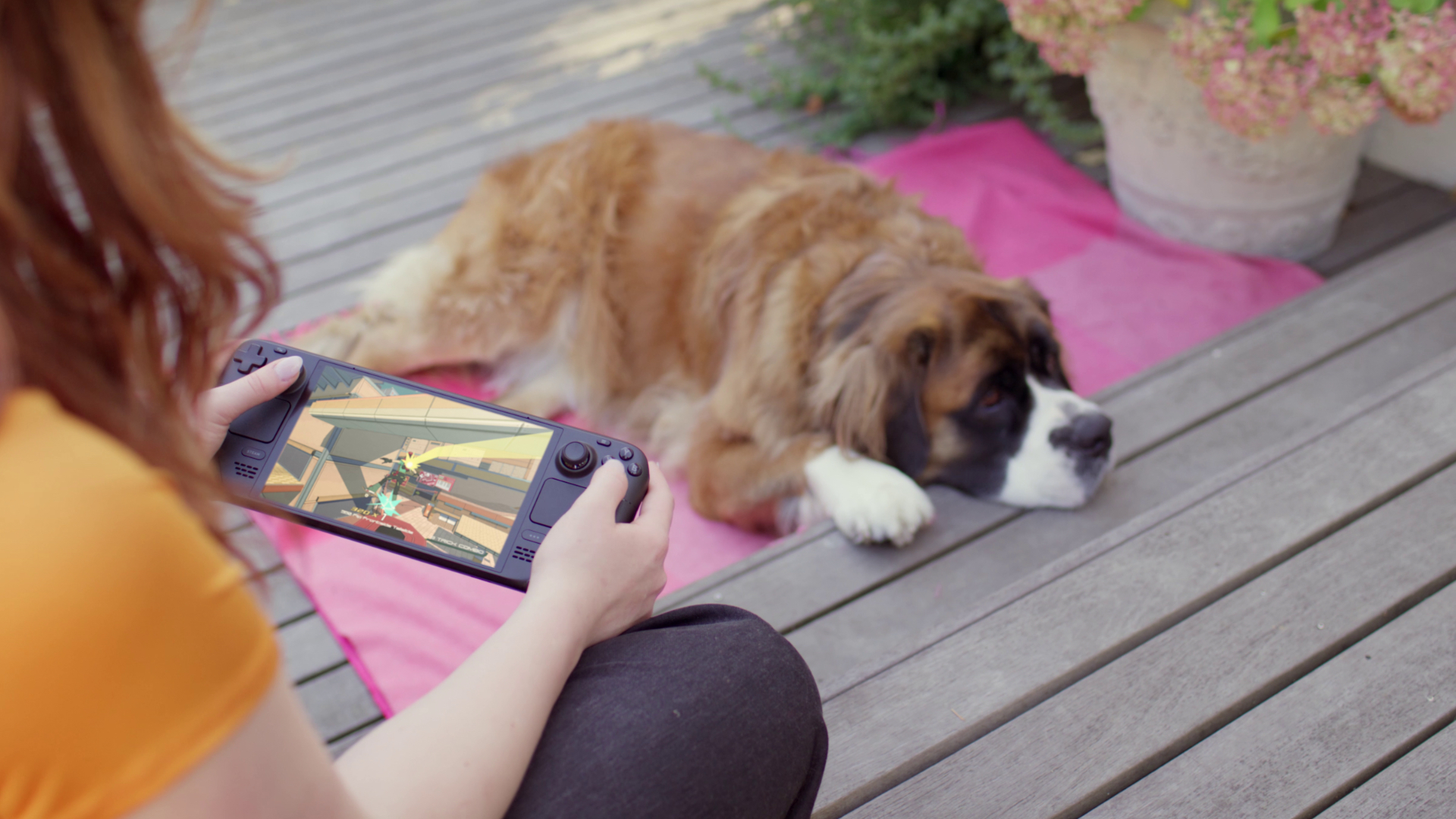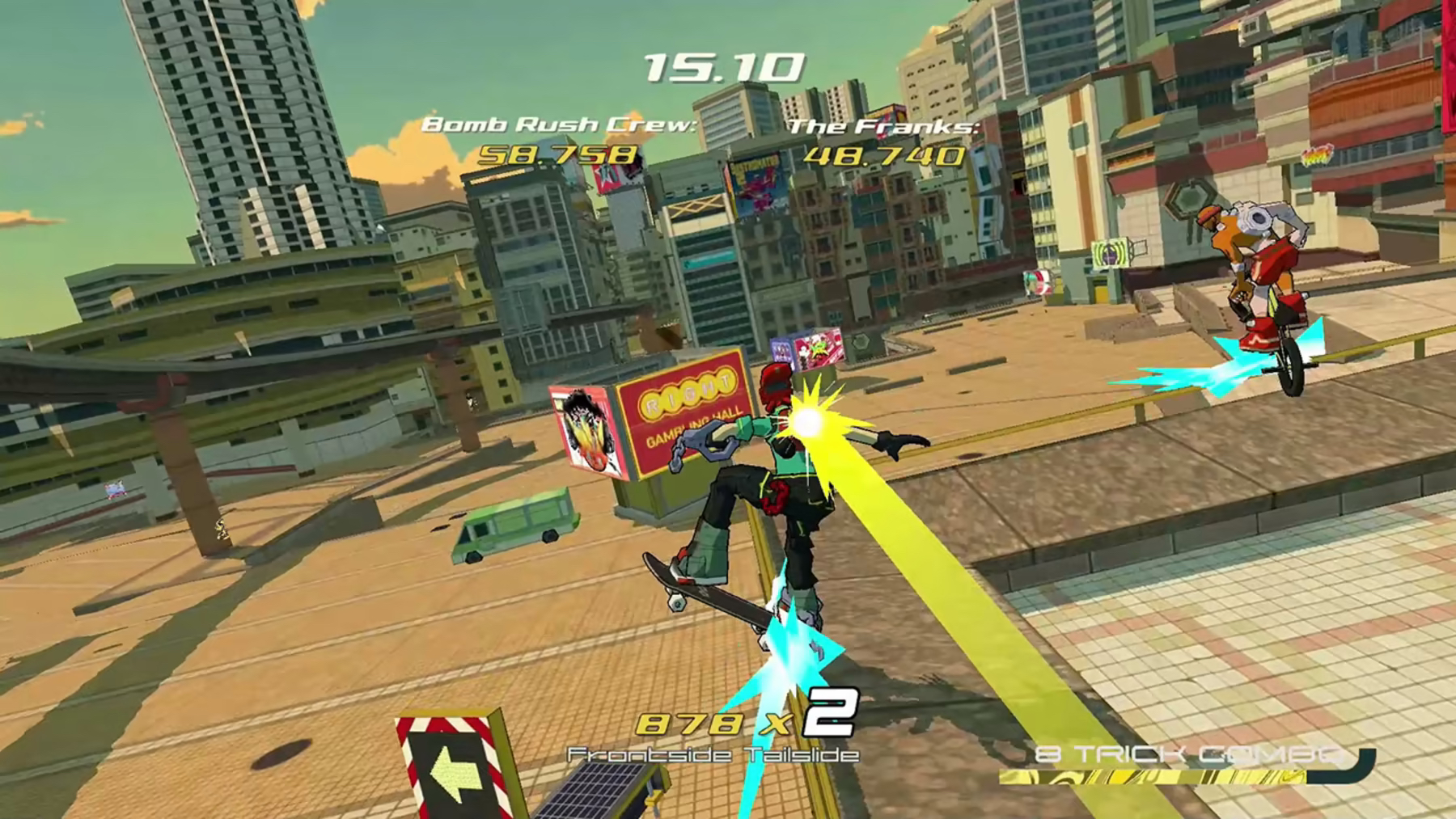A few months ago, Team Reptile finally released Bomb Rush Cyberfunk on consoles and PC platforms. Many consider it a spiritual successor to Jet Set Radio, and it does a lot to look and feel amazing and fresh throughout. I’ve played it on multiple platforms, and it is a superb experience for portables that shines on the Steam Deck. While Bomb Rush Cyberfunk was a digital release at launch, it screamed for a good physical edition. That finally happened with iam8bit and Skybound Games. Following that launch, I got to chat with Team Reptile’s Dion Koster about his career, the game, music, his dancing, the future, and more.
TouchArcade (TA): For those unaware, tell us a little bit about yourself and what you do at Team Reptile.
Dion Koster (DK): Hello, I am Dion Koster, game director and co-founder of Team Reptile. I’m hands-on with many facets like character design and modeling, gameplay design and programming and writing the story. For the rest, I provide direction to the team and pick the music for the soundtrack and such.
TA: How has the Dion Koster who worked on Awesomenauts back in 2012 changed from the one who directed Bomb Rush Cyberfunk?
DK: Now that is a question I did not expect! It’s true, I worked on Awesomenauts as a game design intern. Although it was in mid-development in 2009, before Team Reptile started in 2011. The best way to describe it is that at that time I kept my personal style and life mostly separated from work, it only subconsciously seeped in. From a young age, I have been dancing, skating and writing graffiti, over the years it became a theme in my work before finally becoming the subject with Bomb Rush Cyberfunk.

TA: As Game Director, what was your core philosophy during the project’s development?
DK: Formulated into an interview answer there is not enough room for nuance, but I strongly believe we should make things that are loudly personal. The uncomfortability of loudness only needs to be limited by the point of frustration. As long as it then actually comes from life and self expression it will have a high impact.
TA: While the aesthetic and graffiti art is all amazing, the one area I want to highlight is the user interface. This is one area a lot of games falter on, but Bomb Rush Cyberfunk absolutely nails it. Tell us a little bit about how the interface evolved over the course of the game’s development.
DK: Thank you for the kind words! Sem Graham is an amazing artist who does the graphic design. Think billboards, props, all the mascots. He had designed a preliminary version of the UI, but well, it turned out too ‘videogamey’. Looking at the first illustrations I did of the game, I remembered my obsession with fluid dynamics. These marbling patterns took the style away from simply retro and added a dreamy, brain fluid-like layer that spoke of the themes in the story. Realizing this I had Sem and programmer Niels Vriezen make it a recurring motif throughout the game.
— Team Reptile (@ReptileGames) June 28, 2023
TA: I’ve seen clips of your dancing used in-game. Was that mo-capped during development?
DK: That is correct. I just danced on my own when I was young, but started getting into it around the end of 2003. So by now, I have been dancing for 20 years. It is breaking and locking that I do most and basically my whole circle is involved in street culture. Downstairs in our Team Reptile office ‘De Bass’ there’s a studio where there are dance sessions every week and we do some recording. Everybody is happy to provide mocap of course and I had to jump in myself too.
TA: While obviously these are important for all games, I feel like art, music, and gameplay feel even more important for a game like Bomb Rush Cyberfunk. How did you approach curating the soundtrack for the game?
DK: I wanted the music to have some technologic or cyber elements mixed with funk or hard beats and preferably really danceable. So I let my dance ear guide me a lot. Only some tracks were made specifically for the game, most of them were already out there. Which is another thing I went for, music that says something more than just ‘this is a videogame’. It has its own voice. People often came to me with music inspired by the game and I had to reject them sadly. Because then the layer of extra meaning is removed and the whole thing is flat.

TA: Obviously the game is in an amazing place right now, but do you want to do more with it?
DK: Before Bomb Rush Cyberfunk we made Lethal League and Lethal League Blaze. Both these titles were online and competitive. Of course, this required a lot of attention constantly. Bomb Rush Cyberfunk stands in stark contrast being a singleplayer game with an ending – a rarer thing these days. I believe that its story has been concluded and there is no artistic reason to reanimate it. There are many more experiences to be expressed, but they would shine only in a completely new game.
TA: How have you felt about the response and feedback from players and the media?
DK: I am very happy to receive so much positive feedback. But there is one thing that goes above and beyond. It is when people tell me they have picked up skating, dancing or going out because of the game.
TA: We are now getting two Bomb Rush Cyberfunk physical releases through iam8bit and Skybound. Did you always plan to have a physical release?
DK: I think we presumed it, but when you are working hard to finish a game, it is sometimes difficult to step back and actually make moves to get it sorted.

TA: How did you decide what to include in the physical release and in the vinyl soundtrack?
DK: Adding stickers was one of the quickest decisions to make. It just fits in line with the idea of the game. I felt like the graffiti booklet in the iam8bit Exclusive Edition was also really good to show that there are voices behind all the styles we are featuring. They stand on their own too, you know. And the vinyl, of course vinyls are actually represented in the game. Both in and outside the game I wanted the records to look like proper club-spun records. Fun fact: on the cover is a photo of a big fungus we found.
TA: Digital Foundry mentioned great keyboard and mouse controls in Bomb Rush Cyberfunk (on Steam). This isn’t a game I’d expect to have good keyboard and mouse support at all, so I wanted to know how much work went into optimizing it for multiple control options.
DK: In the early days of Team Reptile it was way easier to release on PC than consoles, even though we liked making action arcade-like experiences. So we became used to dealing with keyboard and mouse for our type of games. Still, during healthy development the input layout switches around so we had a bunch of that too. My decision to remove all important actions from the face buttons on gamepads and replace them all with just tricks and jumping was a big one. Same for the mouse buttons. But it worked cause even if they weren’t the most important, it is the stuff you are doing most of the time.

TA: What were your major gaming influences for Bomb Rush Cyberfunk outside of the obvious Jet Set Radio.
DK: Honestly I could fill the page with influences outside of gaming! But if you are going to limit it like that… I looked a lot at the Tony Hawk’s Pro Skater series, SSX and many other trick games. Grand Theft Auto too. If I stretch the definition, I can mention the graffiti minigame is inspired by a phone unlock screen. Story-wise, Ghost Trick is the greatest of all time, it might not be apparent, but I think it has influenced my work too.
TA: What have you been playing this year?
DK: I feel like there have been a lot of mid releases this year for me personally. I have more so been enjoying myself watching my girlfriend do interior design in Sims 4.
TA: What’s next for Team Reptile after the physical launch of Bomb Rush Cyberfunk?
DK: We are already creating the next game to be honest! Making Bomb Rush Cyberfunk was really fun so we are doing more in the same vein. Leveled up and wilder. At this moment it is mostly pre-production. There are so many things to show and stories to tell when it comes to the meeting of futurism and street culture, I am excited!
I’d like to thank Dion Koster from Team Reptile and Jordan Boyd from fortyseven communications for their time and help with this interview.
You can keep up with all our interviews here including our recent ones about Sonic Dream Team, Football Manager 2024, Hi-Fi Rush, Pentiment, and more.